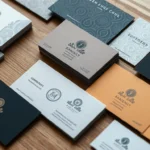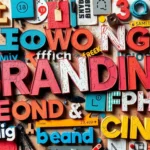Ever wondered why some designs grab your attention right away, while others just don’t? The answer might be in typography. In graphic design, it’s key for visual communication and brand identity. Every detail, from font to letter spacing, shapes a message that connects with your audience.

Typography is more than picking nice fonts. It’s about creating an experience that leads the reader’s eye, shares feelings, and boosts readability. Whether it’s a logo, website, or marketing materials, your typographic choices are crucial. They can make or break your design’s success. Let’s dive into why typography is so vital in graphic design and how it affects your audience’s view.
Key Takeaways
- Typography enhances readability and visual appeal, improving user experience
- Font choices significantly impact brand recognition and consistency
- Effective typography establishes visual hierarchy and guides viewer attention
- Creative typography captures attention and makes messages more memorable
- Typography conveys brand personality and evokes specific emotions
- Proper typography design promotes accessibility for all users
- Consistent typography creates harmonious and visually appealing layouts
Ready to improve your designs with expert typography? Find skilled typography designers on Fiverr to bring your vision to life.
Understanding Typography in Graphic Design
Typography is key in graphic design. It’s not just picking a font. It shapes how people see and interact with your message. Let’s explore typefaces, kerning, and visual hierarchy.
Definition of Typography
Typography is the art of arranging text for clarity and appeal. It involves choosing typefaces, setting font sizes, and managing spacing. Good typography makes your design strong and engaging.
Role of Typography in Visual Communication
Typography is a powerful tool in design. It guides the viewer’s eye and organizes information. It can evoke emotions and show your brand’s personality. Effective typography makes your message clear and memorable.
Elements of Typography Design
Key parts of typography include:
- Typeface selection
- Font style and weight
- Kerning and leading
- Text alignment
- Color and contrast
These elements help create a clear visual hierarchy. By mastering them, you can make designs that grab attention and communicate well.
| Typeface Category | Common Uses | Example Fonts |
|---|---|---|
| Serif | Print materials (books, newspapers) | Times New Roman, Garamond |
| Sans-serif | Digital media (websites, apps) | Arial, Helvetica |
Want to improve your design with great typography? Hire a skilled graphic designer to make your vision come to life.
The Power of First Impressions: Typography’s Impact on Attention
Typography has a huge impact on grabbing attention. The right fonts, sizes, and arrangements can make your design pop. This visual appeal draws people in and keeps them interested.
Creative typography is more than just text. It’s an art that sends messages without extra visuals. Bold, unique, or stylized fonts make your design memorable and stand out.
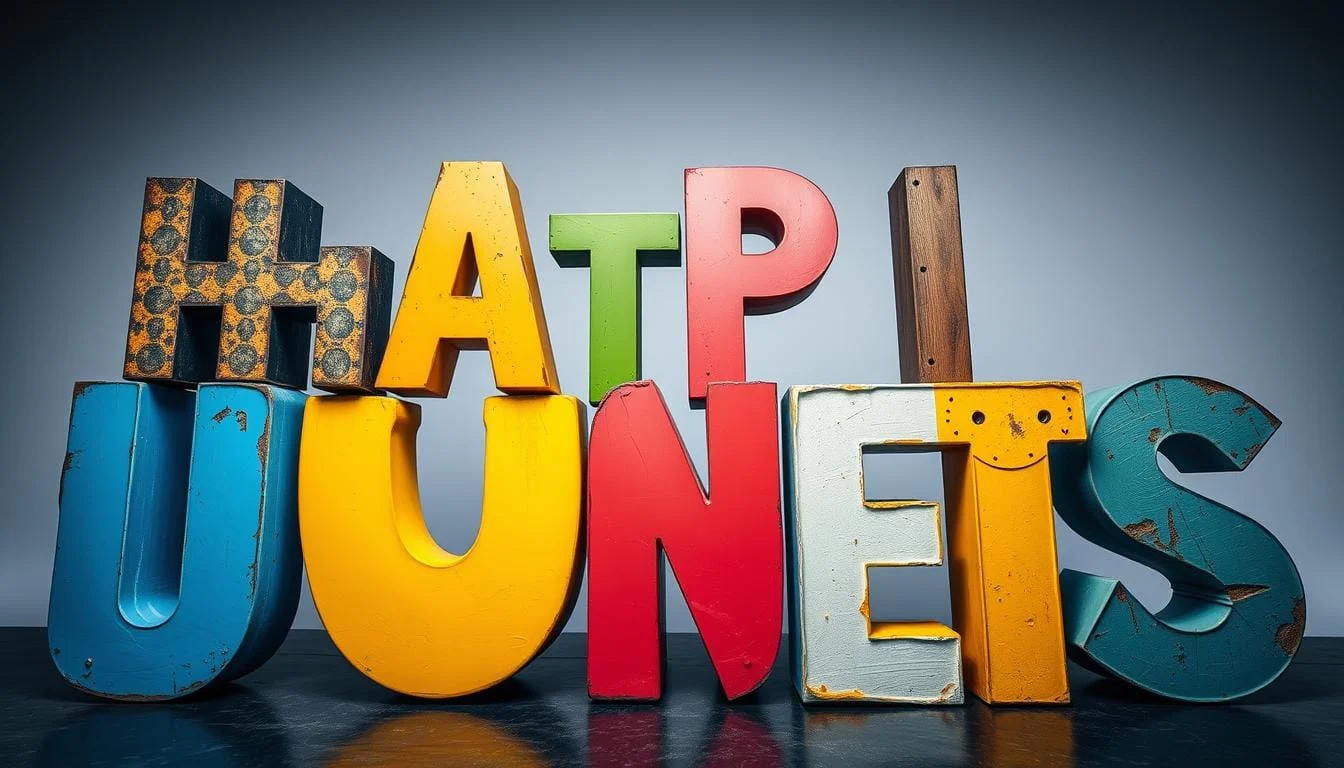
The look of your typography is key to making your designs unique. It sparks curiosity and gets people engaged. Here are some stats on why typography matters:
- 90% of online info is text
- Good typography makes content accessible to more people
- Effective typography boosts user engagement and sales
Bad typography can make your design look unprofessional. To make a strong first impression, focus on typography that fits your brand and speaks to your audience.
| Typography Element | Impact on First Impression |
|---|---|
| Font Choice | Sets the tone and personality of the design |
| Size and Hierarchy | Guides the viewer’s eye and emphasizes key information |
| Color and Contrast | Enhances readability and creates visual interest |
| Spacing and Layout | Improves overall legibility and aesthetic appeal |
Mastering these typography elements will make your designs unforgettable. Need help with your typography? Hire a skilled freelancer to take your visual communication to the next level.
Enhancing Readability and Accessibility Through Typography
Typography is key to making your content easy to read and accessible. It helps in creating a better experience for everyone, including those with visual impairments. This is done by focusing on legibility and visual clarity.
Choosing Legible Fonts
Choosing the right font is crucial for better readability. Sans-serif fonts like Arial, Verdana, or Helvetica work well on screens. They have clear shapes that help in recognizing characters.
It’s wise to stick to three fonts or fewer. This keeps your design looking consistent.
Optimizing Font Sizes and Spacing
Font size is important for readability. A 16px size is good for body text, with headings being larger (24px to 48px). Line spacing, or leading, should be about 1.5 times the font size.
For example, a 16px font should have a 24px line height. Letter spacing and line length also play a role. Try to keep lines with 60-75 characters for easy reading.

Considering Contrast and Color
Color contrast is crucial for accessibility. The Web Content Accessibility Guidelines (WCAG) suggest a contrast ratio of at least 4.5:1 for body text. This makes text stand out against its background, helping all users, especially those with visual impairments.
| Typography Element | Recommendation | Impact on Accessibility |
|---|---|---|
| Font Size | 16px for body text | Improves readability across devices |
| Line Spacing | 1.4-1.6 times font size | Enhances text legibility |
| Color Contrast | 4.5:1 ratio minimum | Ensures readability for visually impaired users |
| Font Choice | Sans-serif for screens | Aids character recognition |
By following these typography best practices, you can make your content more readable and accessible. Need help with your website’s typography? Hire a skilled freelancer to make sure your design is both beautiful and accessible to everyone.
Creating Visual Hierarchy with Typographic Elements
Typography is key in graphic design for organizing information. By changing font sizes, weights, and styles, you can lead readers through your content. It’s all about using typographic elements to make a clear visual structure.
Choosing the right fonts is crucial for a good hierarchy. Mixing different types, like serif and sans-serif fonts, helps highlight different levels of info. For example, bold sans-serif fonts work well for headings, while serif fonts are better for body text.

The classic typographic scale offers various sizes for text. Body text usually ranges from 14 to 24 pixels for easy reading online. Headings and subheadings should be bigger to stand out and add emphasis.
| Element | Font Size (px) | Font Weight |
|---|---|---|
| Main Heading | 36-48 | Bold |
| Subheading | 24-30 | Semi-bold |
| Body Text | 14-18 | Regular |
Color, capitalization, and weight changes can also highlight important text. By playing with these typographic rules, you can make layouts that are both beautiful and easy to read. This helps guide your audience through your content smoothly.
Need help with your typographic hierarchy? Consider hiring a skilled graphic designer to improve your designs.
Why Are Fonts Important: Conveying Personality and Brand Identity
Fonts are key in shaping a brand’s identity and connecting with people. They’re more than just letters; they’re tools for emotional design and brand recognition.
Matching Fonts to Brand Personality
Your font choice says a lot about your brand. Serif fonts, liked by 58% of law firms, show tradition and reliability. On the other hand, 72% of modern brands choose sans-serif fonts for a minimalist look.
Luxury brands often pick script fonts, with 64% using them for elegance.
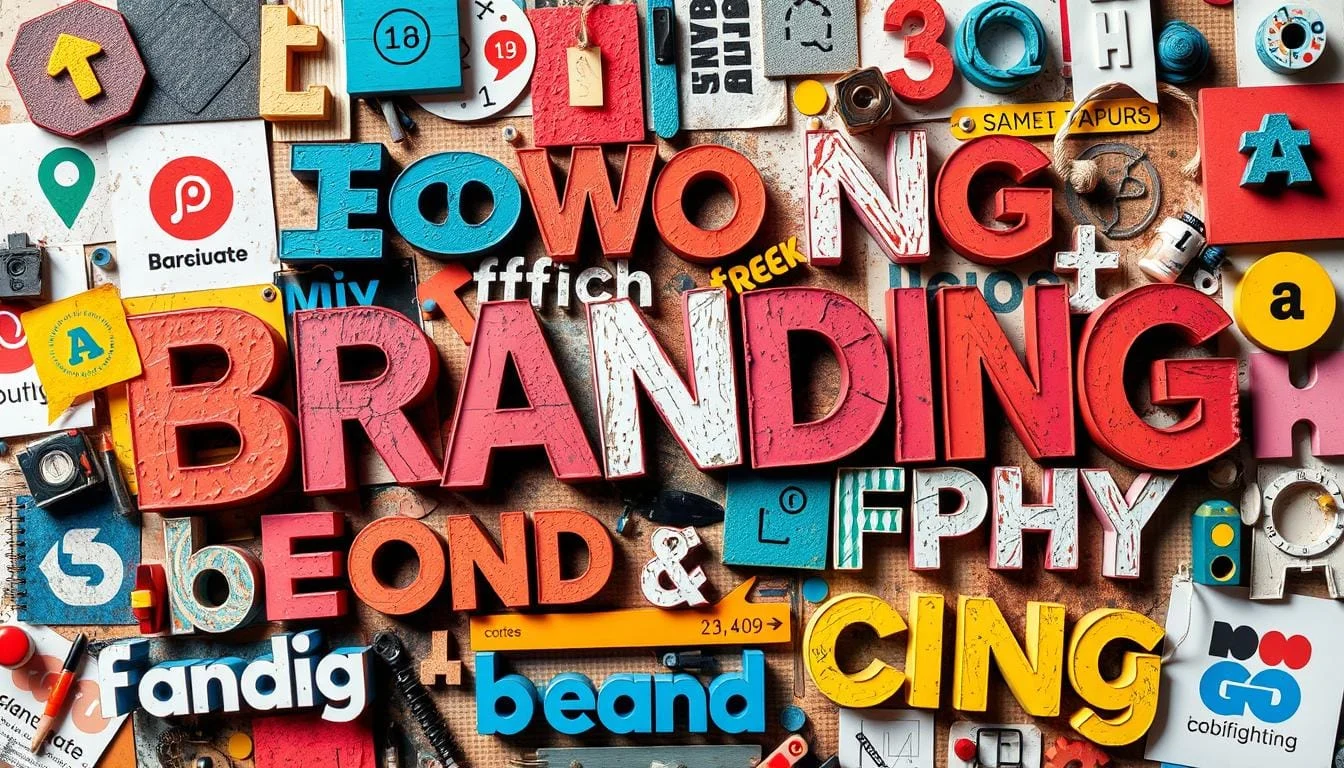
Creating Emotional Connections Through Typography
Typography is vital for emotional design. The style, size, and spacing of letters greatly affect how people see your brand. Rounded fonts feel close and soft, while geometric sans-serif fonts seem timeless.
By picking fonts that match your brand values, you can build stronger connections with your audience.
Consistency in Font Usage Across Platforms
Being consistent in font usage across all platforms is key for trust and recognition. In fact, 72% of consumers trust brands more when they use the same font everywhere. This consistency strengthens your brand identity and gives your audience a unified visual experience.
| Font Type | Brand Personality | Usage Percentage |
|---|---|---|
| Serif | Traditional, Reliable | 58% (Law Firms) |
| Sans-serif | Modern, Approachable | 72% (Modern Brands) |
| Script | Luxury, Elegant | 64% (Luxury Brands) |
Choosing the right font is vital for your brand’s success. If you’re unsure, consider hiring a typography expert on Fiverr to help pick fonts that fit your brand perfectly.
The Art of Font Pairing in Graphic Design Elements
Font pairing is key in graphic design. Choosing the right fonts can make your design pop. It adds balance and contrast. Let’s dive into how different fonts work together.
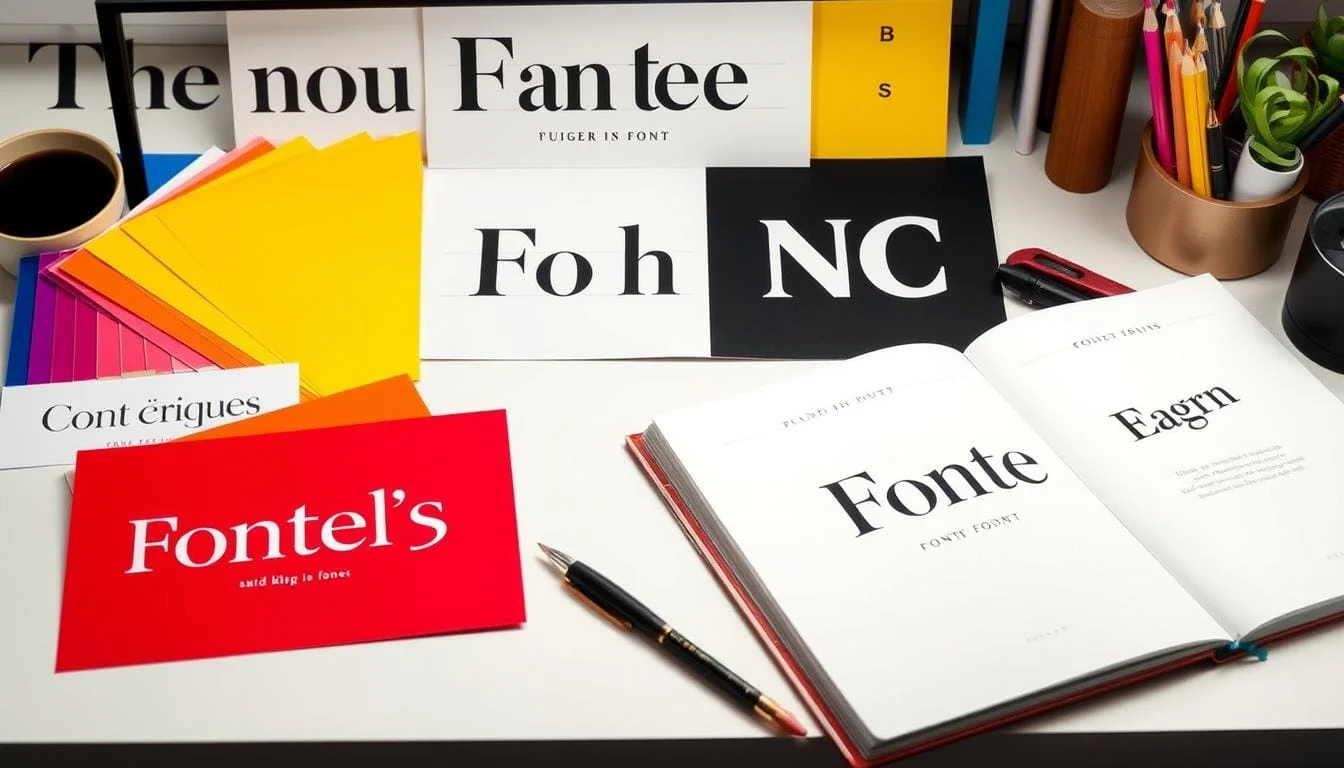
Good font pairing makes your design easy to read and look great. A survey shows 77% of designers think using different font weights or styles adds interest. Think about the mood and purpose of your design – 13% of designers say this is very important.
To keep things simple, use only 2-3 fonts. This helps avoid overwhelming your audience. 64% of designers suggest picking fonts that your audience will like.
Font pairing is not an exact science; experimentation is encouraged for unique designs.
When picking fonts, think about contrast, similarity, and mood. Serif fonts are great for print because of their small lines. Sans-serif fonts are better for digital and web because they lack these lines. Script fonts look like handwriting, and display fonts are perfect for headlines.
| Font Type | Characteristics | Best Used For |
|---|---|---|
| Serif | Small decorative lines | Print design |
| Sans-serif | No decorative lines | Digital and web design |
| Script | Mimics handwriting | Decorative elements |
| Display | Bold, attention-grabbing | Headlines and titles |
Need help with font pairing? Hire a freelance designer to create stunning typographic designs for your projects.
Typography as a Tool for User Experience Enhancement
Typography is key to making a website user-friendly. It guides users, helps them remember information, and adds visual appeal. Let’s see how typography improves user experience.
Guiding User Navigation
Good typography makes navigating your site easy. It uses different font sizes and styles to draw attention to key points. This follows information architecture principles, helping visitors find what they need.
Improving Information Retention
Engaging typography boosts how well users remember information. Using clear fonts and proper line spacing helps them understand better. Aim for 50-75 characters per line for best readability. Sans-serif fonts are great for body text in web design.
Creating Visual Interest and Engagement
Typography is not just about being easy to read; it also adds visual appeal. Creative use of typography can grab attention and keep users interested. Decorative fonts can make headings stand out while keeping body text readable.
Typography greatly affects user experience. A study found that changing font styles improved website engagement by 38%. Another showed that using Georgia font increased time spent on pages compared to Arial and Verdana.
| Font Size | Engagement Level | Impact on Metrics |
|---|---|---|
| 14px | Highest | 7.1% lower bounce rate, 18.18% more pages viewed |
| 15px | Medium | No significant change |
| 16px | Lowest | No significant change |
Typography is a crucial design element that can greatly impact user experience. By using these tips, you can make your website more engaging and effective. Need help? Hire a skilled freelancer to improve your typography.
The Role of Typography in Establishing Brand Recognition
Typography is key in shaping your brand’s identity and recognition. It’s more than picking a font; it’s about finding a visual voice for your brand. This voice is heard through your logo, website, and all content, making your brand’s look consistent.
Think about how brands like Coca-Cola, Disney, and Harry Potter are instantly recognizable. Their unique typography is a big reason why. It shows how well-chosen letters can leave a lasting impression on your brand.
“Type is a visual voice” – Laura Worthington
This quote highlights the need for typefaces that match your brand’s values and message. Different fonts can create different feelings and connections:
- Sans-serif fonts: Modern and clean
- Serif fonts: Traditional and reliable
- Script fonts: Personal and creative
- Monospaced fonts: Technical and precise
Many companies have created their own typefaces to keep their brand look consistent everywhere. Netflix, Airbnb, and Apple are great examples of this approach to visual identity.
| Brand Element | Importance of Typography |
|---|---|
| Logo | Creates instant recognition |
| Website | Enhances user experience |
| Marketing Materials | Reinforces brand messaging |
| Social Media | Maintains visual consistency |
Your typography choices greatly affect how customers see your brand. To make sure your visual identity truly reflects your brand, consider getting professional help. Work with a typography expert to craft a memorable and consistent brand identity.
Typography’s Influence on Marketing and Conversion Rates
Typography is key in marketing and improving conversion rates. The way you display text can greatly affect your advertising success. In the digital world, every detail matters, and your font choices can significantly influence how people feel about your brand.
Typography in Call-to-Action Buttons
Your call-to-action (CTA) buttons are crucial for getting people to take action. A/B testing reveals that small changes in CTA typography can make a big difference. Bold, clear fonts usually work better than complex ones. For the best results, use a 16-pixel font size on desktops and 14 pixels on mobiles.
Right Font Choice in Advertising Materials
In advertising, keeping your typography consistent is important. Using the same fonts in all your ads helps your brand stand out and work better. Also, high contrast between text and background makes your ads easier to read, especially on smaller mobile screens.
Typography’s Impact on Consumer Trust
Good typography in your digital content can make users more engaged and spend more time on your site. Proper line spacing makes reading easier and reduces eye strain, building trust with your audience. By focusing on typography in your marketing, you’re not just designing – you’re communicating effectively.
Want to improve your marketing typography? Hire a skilled typographer on Fiverr to boost your conversion rates today.
FAQ:
For the subject “7 Reasons Why Typography Is Important in Graphic Design and Font Choice”
Q: Reasons why typography is important in graphic design?
A: Typography is important in graphic design because it plays a significant role in communicating the message, establishing a visual hierarchy, and contributing to the overall design aesthetic. The right typeface can make or break a design project, influencing readability, brand identity, and the tone of the message. Typography is a powerful design element that can evoke emotions, guide the viewer’s eye, and enhance the overall visual impact of a design.
Q: What is the importance of typography in graphic?
A: There are several reasons why typography is important in graphic design: 1. It enhances readability and legibility 2. It establishes brand identity and consistency 3. It creates visual hierarchy and guides the viewer’s attention 4. It evokes emotions and sets the tone 5. It improves overall aesthetics and visual appeal 6. It helps convey the message effectively 7. It can make or break a design project
Q: How does typography contribute to establishing a visual hierarchy?
A: Typography plays a crucial role in establishing a visual hierarchy by using different font sizes, weights, and styles to guide the viewer’s eye through the design. By strategically applying typographic elements, designers can emphasize important information, create contrast, and organize content in a way that leads the viewer through the design in a logical and visually appealing manner. This hierarchy helps readers quickly understand the structure and importance of different elements within the design.
Q: Why is choosing the right typeface important in graphic design?
A: Choosing the right typeface is crucial in graphic design because it significantly impacts the overall visual appeal and effectiveness of the design. The right font can reinforce the message, evoke specific emotions, and enhance readability. Different typefaces have distinct personalities – some are formal and serious, while others are playful or elegant. Selecting an appropriate typeface ensures that the design aligns with the brand identity, target audience, and the tone of the message being conveyed.
Q: How does typography affect logo design?
A: Typography plays a vital role in logo design as it can make or break the overall impact and memorability of a logo. The choice of typeface in a logo contributes to brand identity, conveying the company’s personality and values. Whether using a custom typeface, modifying an existing one, or choosing from many fonts available, the typography in a logo design should be carefully considered to ensure it’s legible at various sizes, unique, and aligned with the brand’s image. The power of typography in logo design can create a lasting impression on viewers and help establish brand recognition.
Q: What are some common mistakes to avoid when using typography in graphic design?
A: Some common mistakes to avoid when using typography in graphic design include: 1. Using too many fonts in a single design 2. Neglecting readability for the sake of aesthetics 3. Improper kerning and leading 4. Ignoring contrast between text and background 5. Overusing decorative or script fonts 6. Failing to establish a clear hierarchy 7. Not considering the design’s context and medium 8. Mismatching typefaces that clash stylistically By avoiding these pitfalls, designers can ensure that typography enhances rather than detracts from the overall design.
Q: How does typography influence the tone of a message in graphic design?
A: Typography significantly influences the tone of a message in graphic design by visually representing the voice and personality of the content. Different typefaces can evoke various emotions and associations – for example, a sans serif font might convey a modern and clean feel, while a script font could suggest elegance or creativity. The weight, style (such as italic or bold), and size of the text also contribute to the overall tone. By carefully selecting and manipulating typographic elements, designers can reinforce or even transform the tone of the written language, ensuring it aligns with the intended message and brand identity.
Q: How can designers effectively use typography to improve their projects?
A: Designers can effectively use typography to improve their projects by: 1. Understanding the principles of typography and how they relate to design elements 2. Choosing typefaces that complement the project’s goals and target audience 3. Creating contrast through size, weight, and style variations 4. Ensuring proper hierarchy to guide the viewer’s eye 5. Maintaining consistency in typography usage across the design 6. Considering readability and legibility in different contexts (print, digital, etc.) 7. Experimenting with typography as a design element (e.g., using text as a visual element) 8. Staying updated on typography trends and best practices By mastering these aspects of typography, designers can significantly enhance the impact and effectiveness of their design projects.
Source Links
- Master the art of using fonts to elevate your design’s visual impact.
- Text on a white background for clean, crisp designs.
- Apply fundamental design principles to create compelling visuals.
- Typography is the strategic art of arranging type for maximum impact
- Partner with a professional design agency to bring your vision to life.
- Design plays a significant role in how your message is perceived and remembered.
- Choosing the right typography can make your design’s effectiveness.
- Our design is a leading example of how typography can enhance brand
- Select a specific font that aligns with your personality and values.
- Understand the nuances between typefaces and font styles for impactful designs.
- Typography is one of the most crucial elements in effective visual communication.
- Master the art of selecting and pairing fonts for harmonious designs.
- Want to learn more about typography? Explore our comprehensive design resources.
- Why Is Typography Important
- Choose fonts that are difficult to read, as they can detract from your message.
- Typography plays a huge role in conveying your tone and personality.
- Black text on a white background offers optimal visuals in most cases. Graphic Designers say
- Choose a serif typeface for a traditional, authoritative look in your designs.
- Consider people with visual impairments when selecting color contrasts.
- Create a clear visual hierarchy of information through smart choices.
- The right font can influence how your audience perceives your message.
- Explore unique font designs to make your brand stand out from the competition.
- Why is Typography Important for Your Brand?
- Typography helps make written language visually appealing and easier to comprehend.
- Lettering can even be used to convey emotion and set the tone for your design.
- Typography is key to effective communication in both print and digital media.
This post contains affiliate links, which means I may earn a commission if you make a purchase through these links. There is no additional charge to you! Thank you for supporting my blog so I can continue creating free content each week!


